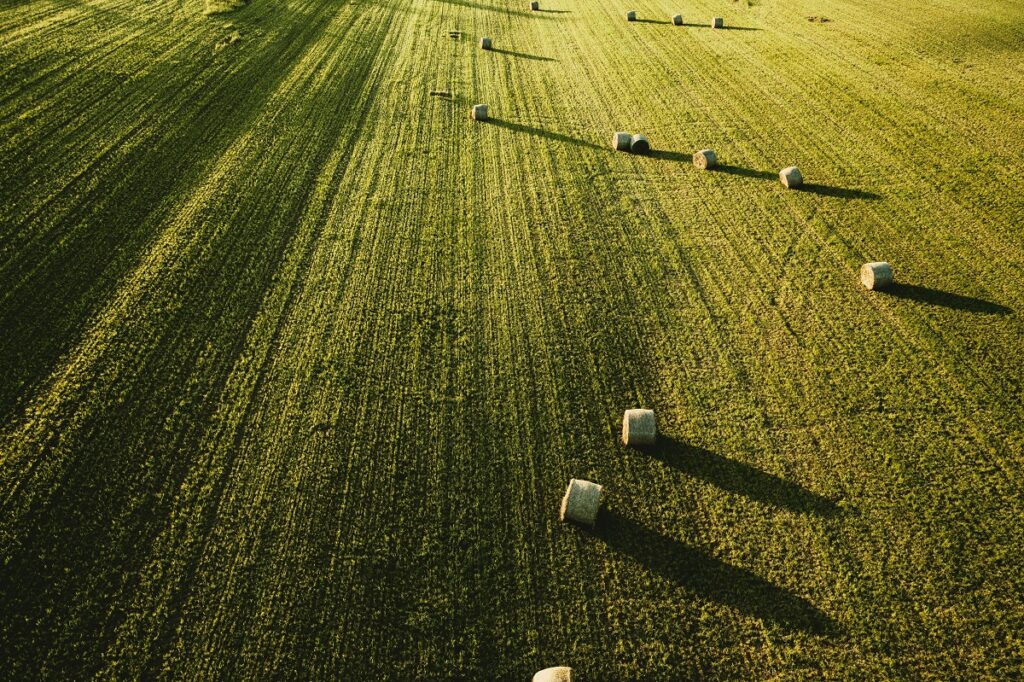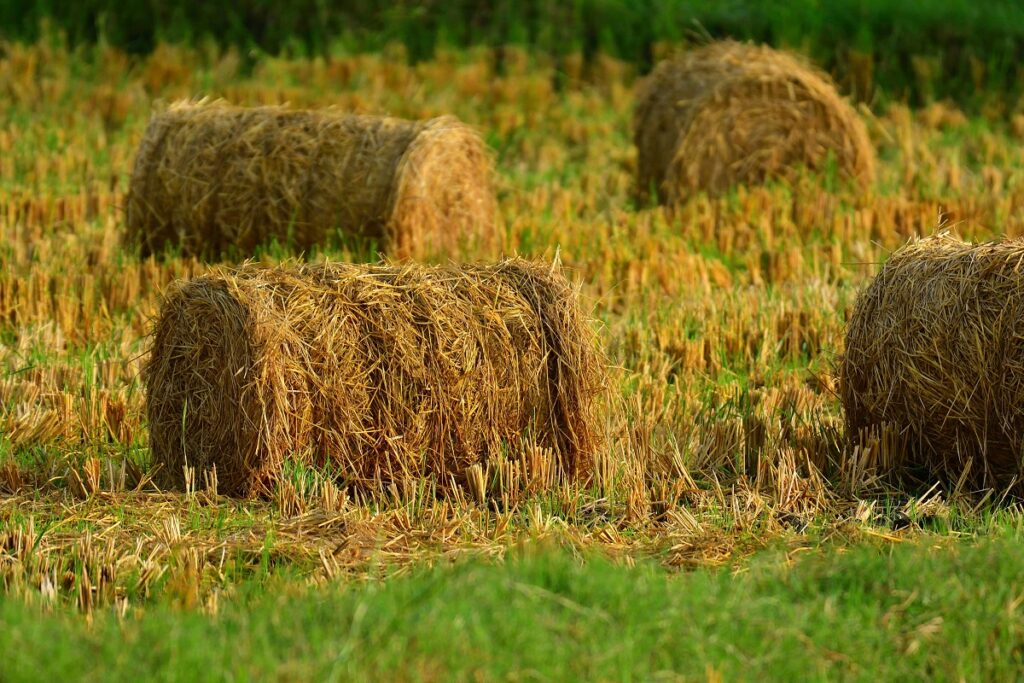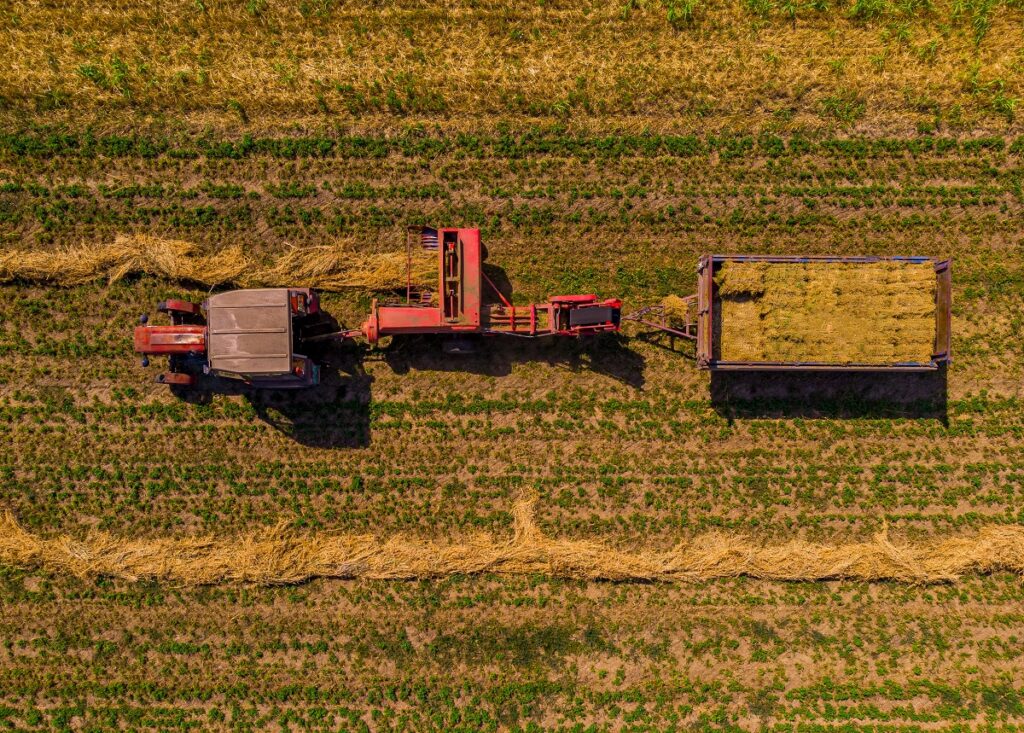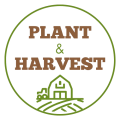When feed costs are skyrocketing and drought conditions challenge pasture availability, smart farmers turn to one of agriculture’s most reliable solutions: hay production. But what exactly is hay, and how can you produce premium-quality forage that maximizes nutrition while minimizing costs?
Whether you’re a seasoned rancher looking to optimize your hay operation or a beginning farmer exploring forage options, this comprehensive guide will walk you through every step of successful hay production – from field to barn.
What Is Hay? Understanding the Fundamentals
Hay is dehydrated forage made from grasses, legumes, or other herbaceous plants that have been cut, dried, and stored for livestock feed. The process transforms fresh, perishable forage into a stable, nutrient-dense feed that can be stored for months or even years when properly managed.
The key difference between hay and other forage lies in moisture content. Fresh pasture contains 70-85% moisture, while properly cured hay contains only 15-20% moisture. This dramatic reduction in water content prevents spoilage, allows for long-term storage, and concentrates nutrients into a convenient, transportable form.
Types of Hay: Understanding Your Options
Grass Hay:
- Timothy, orchardgrass, brome, fescue
- Higher fiber, lower protein
- Excellent for horses and maintenance rations
Legume Hay:
- Alfalfa, clover, birdsfoot trefoil
- Higher protein, calcium-rich
- Ideal for dairy cows and growing animals
Mixed Hay:
- Combination of grasses and legumes
- Balanced nutrition profile
- Versatile for various livestock needs
Why Produce Hay? The Economic and Practical Benefits
Financial Advantages
Cost Control: Producing your own hay can reduce feed costs by 40-60% compared to purchasing premium hay, especially during drought years when hay prices spike.
Market Opportunities: Quality hay commands premium prices. According to USDA market reports, prime alfalfa hay sells for $200-300+ per ton in many regions.
Risk Management: On-farm hay production provides insurance against feed shortages and price volatility.

Operational Benefits
Feed Security: Ensures consistent feed availability regardless of weather conditions or market disruptions
Quality Control: Direct oversight of production practices guarantees feed quality and safety
Flexibility: Ability to time harvests for optimal nutrition and adjust production based on livestock needs
Land Utilization: Maximizes productivity of marginal or rotating cropland
Best Forage Species for American Hay Production
Premium Grass Options
Timothy (Phleum pratense)
- Best for: Northern regions, horse hay
- Protein: 8-12%
- Yield: 2-4 tons per acre
- Characteristics: High palatability, excellent for horses
Orchardgrass (Dactylis glomerata)
- Best for: Transition zones, mixed species stands
- Protein: 10-14%
- Yield: 3-5 tons per acre
- Characteristics: Early maturity, good regrowth
High-Value Legumes
Alfalfa (Medicago sativa)
- Best for: Western irrigated regions, dairy operations
- Protein: 18-22%
- Yield: 4-8 tons per acre
- Characteristics: Highest feeding value, nitrogen-fixing
Red Clover (Trifolium pratense)
- Best for: Humid regions, beef cattle
- Protein: 15-18%
- Yield: 2-4 tons per acre
- Characteristics: Good in grass mixtures, soil improvement
Regional Specialties
Bermudagrass (Southeast)
- Heat and drought tolerant
- Multiple cuttings per season
- Excellent for beef cattle
Sudan-Sorghum Hybrids (Great Plains)
- Annual crop option
- High tonnage potential
- Drought resistant
Step-by-Step Hay Production Process
Step 1: Field Preparation and Planning
Soil Testing: Conduct annual soil tests to determine pH, fertility, and lime requirements. Most hay crops perform best with pH 6.0-7.0.
Fertilization Strategy: Apply phosphorus and potassium based on soil test recommendations. Legumes require less nitrogen due to biological fixation.
Weed Management: Control broadleaf weeds and grasses that reduce hay quality and yield.
[Image suggestion: Farmer taking soil samples in hayfield with testing kit. Alt: “Soil testing for optimal hay field management and fertilizer application”]
Step 2: Timing the Cut – Critical for Quality
Optimal Cutting Stages:
- Grasses: Late boot to early head emergence
- Legumes: Early bloom (10% flowering)
- Mixed stands: When dominant species reaches optimal stage
Timing Considerations:
- Cut during stable weather patterns (2-3 day drying window)
- Avoid cutting during wet periods or before rain
- Morning cuts (after dew dries) optimize drying conditions
Step 3: Cutting Operations
Equipment Options:
- Disc Mowers: Clean cut, faster speeds, handle heavy crops
- Sickle Bar Mowers: Lower cost, good for uneven terrain
- Mower-Conditioners: Cut and condition in one pass
Cutting Height Guidelines:
- Leave 3-4 inches for regrowth and plant health
- Higher cuts in hot, dry conditions
- Lower cuts on final harvest of season
Step 4: Field Curing – The Make-or-Break Stage
Moisture Management:
- Target 15-20% moisture for safe storage
- Use moisture meters for accurate readings
- Monitor weather forecasts constantly
Tedding and Raking:
- Ted (spread) hay 2-4 hours after cutting
- Rake into windrows at 35-40% moisture
- Minimize leaf loss through gentle handling
Weather Challenges:
- Light rain: May wash leaves but won’t ruin hay
- Heavy rain: Significant quality loss, consider silage option
- Extended wet periods: May require re-tedding
Step 5: Baling Operations
Small Square Bales (14″x18″ typical):
- Weight: 35-50 lbs
- Advantages: Easy handling, precise feeding
- Best for: Small operations, horse hay, retail sales
Large Square Bales (3’x3’x8′ typical):
- Weight: 1,200-1,500 lbs
- Advantages: Efficient harvesting, reduced storage space
- Best for: Large operations, commercial sales
Round Bales (4’x5′ typical):
- Weight: 850-1,200 lbs
- Advantages: Weather resistance, efficient field operations
- Best for: Beef cattle, outdoor feeding
Step 6: Storage and Preservation
Indoor Storage (Premium Option):
- Protects from weather damage
- Maintains highest feed value
- Reduces waste to less than 5%
- Requirements: Adequate ventilation, dry foundation
Outdoor Storage:
- Cost-effective for large operations
- Requires proper site selection and management
- Use net wrap or plastic for weather protection
- Expect 10-20% storage losses
Storage Best Practices:
- Stack bales on pallets or well-drained ground
- Allow air circulation between bales
- Monitor for heating or mold development
- Implement first-in, first-out rotation
Quality Assessment and Testing
Visual Quality Indicators
Excellent Hay:
- Green color retention
- leafy appearance
- Fresh, sweet aroma
- Soft texture
Poor Quality Hay:
- Brown or yellow color
- Stemmy, coarse texture
- Musty or moldy odor
- Excessive dust

Laboratory Testing
Nutritional Analysis:
- Crude protein (CP)
- Acid detergent fiber (ADF)
- Neutral detergent fiber (NDF)
- Relative feed value (RFV)
Cost-Benefit: Testing costs $15-25 per sample but provides valuable information for marketing and feeding programs.
Hay for Different Livestock Species
Dairy Cattle Requirements
Premium Alfalfa Specifications:
- Crude protein: 18-20%
- ADF: Less than 35%
- RFV: Greater than 140
- Minimal dust and mold
Feeding Strategy: High-quality hay supports milk production and reduces concentrate needs by 15-25%.
Beef Cattle Applications
Cow-Calf Operations:
- Moderate quality hay (12-14% protein) adequate for maintenance
- Higher quality needed during pregnancy and lactation
- Cost-effective alternative to grain supplementation
Backgrounding/Growing Cattle:
- Higher protein requirements (14-16%)
- Good quality hay reduces need for protein supplements
Horse Hay Specifications
Critical Quality Factors:
- Dust-free (prevents respiratory issues)
- Mold-free (prevents colic)
- Consistent quality and palatability
- Appropriate maturity (not too mature/stemmy)
Species Preferences:
- Timothy: Excellent for all horses
- Orchard grass: Good alternative to timothy
- Alfalfa: Use carefully due to high protein/calcium
Small Livestock and Specialty Markets
Goats and Sheep:
- Prefer leafy, fine-stemmed hay
- Higher protein requirements than cattle
- Good market for premium small bales
Small Animal/Pet Market:
- Timothy hay for rabbits, guinea pigs
- Premium prices for clean, dust-free hay
- Growing niche market opportunity
Economic Considerations and Profitability
Production Cost Analysis
Variable Costs (per acre):
- Seed: $25-75
- Fertilizer: $50-150
- Fuel/Equipment: $40-80
- Labor: $30-60
- Total: $145-365 per acre
Fixed Costs:
- Equipment depreciation
- Land costs
- Insurance and taxes
- Storage facilities
Revenue Potential
Yield Expectations:
- Grass hay: 2-4 tons per acre
- Legume hay: 3-6 tons per acre
- Mixed stands: 2.5-5 tons per acre
Market Prices (Regional Averages):
- Premium horse hay: $200-350 per ton
- Dairy quality alfalfa: $180-280 per ton
- Beef hay: $120-200 per ton
Marketing Strategies
Direct Sales Advantages:
- Higher profit margins
- Customer relationships
- Quality control
Wholesale Considerations:
- Volume requirements
- Consistent quality standards
- Transportation logistics
Technology and Innovation in Hay Production
Precision Agriculture Applications
GPS-Guided Equipment:
- Reduces operator fatigue
- Improves field efficiency
- Enables consistent cutting patterns
Yield Monitoring:
- Tracks production by field area
- Identifies high and low-yielding zones
- Guides future management decisions

Weather Monitoring Tools
Smartphone Apps:
- Real-time weather data
- Hay drying calculators
- Field condition alerts
Weather Stations:
- Micro-climate monitoring
- Dew point and humidity tracking
- Harvest timing optimization
Storage Innovation
Hay Preservatives:
- Allow baling at higher moisture
- Reduce weather dependence
- Maintain feed quality
Monitoring Systems:
- Temperature sensors in stored hay
- Early warning for heating/combustion
- Remote monitoring capabilities
Common Mistakes and How to Avoid Them
Harvesting Errors
Mistake: Cutting at wrong maturity stage Solution: Monitor crop development and cut at optimal stage for intended use
Mistake: Baling too wet Solution: Invest in moisture meter and test before baling (target 18-20% maximum)
Storage Problems
Mistake: Poor storage site selection Solution: Choose well-drained locations with good air circulation
Mistake: Inadequate protection from weather Solution: Invest in proper storage structures or high-quality outdoor protection
Quality Issues
Mistake: Ignoring weather forecasts Solution: Only cut hay with 2-3 day clear weather window
Mistake: Rough handling causing leaf loss Solution: Adjust equipment speed and settings to minimize mechanical damage
Regulatory and Safety Considerations
Food Safety Modernization Act (FSMA)
For farms selling hay as animal feed:
- Record-keeping requirements
- Hazard analysis protocols
- Supplier verification programs
Worker Safety
Equipment Safety:
- Proper training on all machinery
- Safety guards and shields in place
- Emergency procedures documented
Storage Safety:
- Fire prevention measures
- Proper ventilation in enclosed storage
- Structural integrity of storage buildings
Future Trends and Opportunities
Sustainable Production Practices
Organic Certification:
- Growing market premium
- Strict production requirements
- 3-year transition period
Carbon Sequestration:
- Perennial forages store soil carbon
- Potential for carbon credit markets
- Environmental stewardship benefits
Value-Added Opportunities
Processed Hay Products:
- Chopped hay for easy feeding
- Compressed bales for export
- Specialty blends for specific markets
Agritourism Integration:
- Farm tours and education
- Hay ride entertainment
- Direct marketing opportunities
Conclusion: Building a Profitable Hay Enterprise
Success in hay production comes down to attention to detail, timing, and understanding your market. From selecting the right forage species for your region to mastering the critical field curing process, each step in hay production directly impacts your final product’s quality and profitability.
The fundamentals remain constant: cut at the right stage, cure properly, store correctly, and match your product to your target market. But today’s successful hay producers also leverage technology, embrace sustainable practices, and continuously adapt to changing market conditions.
Whether you’re producing a few hundred bales for your own livestock or managing a commercial operation producing thousands of tons annually, the principles in this guide will help you maximize both quality and profitability.
Remember, hay production is both an art and a science. Start with solid fundamentals, learn from each season’s challenges, and continuously refine your approach. The investment in knowledge and proper equipment pays dividends through higher quality hay, reduced losses, and satisfied customers.
The American hay market continues to evolve, driven by changing livestock nutrition understanding, environmental considerations, and global trade opportunities. Producers who focus on quality, efficiency, and market relationships will find hay production to be a rewarding and profitable enterprise.
Ready to start or improve your hay operation? What specific challenges are you facing with hay production on your farm? Share your questions in the comments below, and don’t miss our related article on “Pasture Management: Maximizing Forage Production and Quality” for comprehensive grazing strategies.




